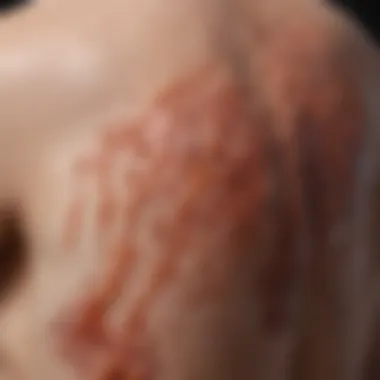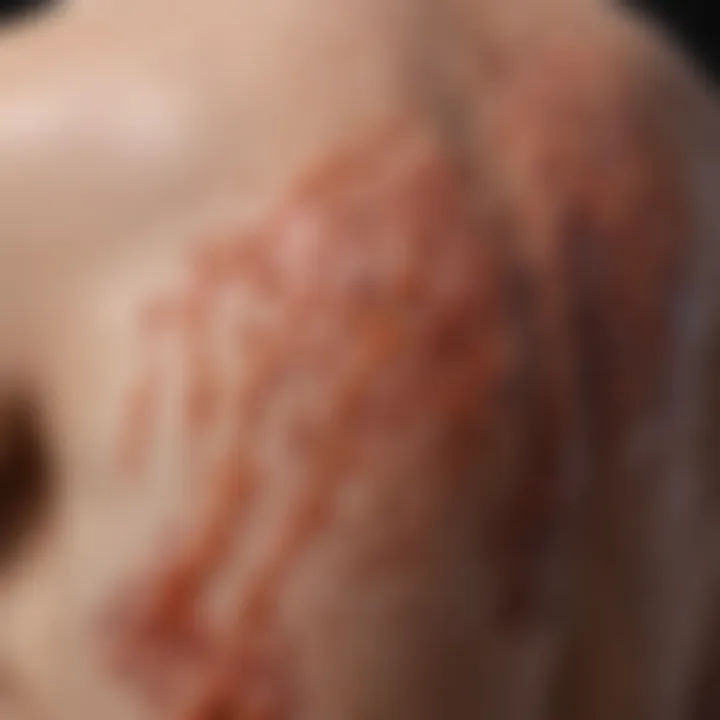Understanding Psoriasis and Eczema: Key Insights


Intro
Psoriasis and eczema are more than just skin conditions; they are intricate ailments that affect not only the skin but also an individual’s mental and emotional well-being. Understanding these conditions requires unraveling their complexities, challenges, and the substantial implications they have on daily life. As we delve deeper into the world of psoriasis and eczema, it's crucial to recognize that they manifest differently in each person. The physical symptoms, such as redness and scaling, are only the tip of the iceberg. The less visible psychological toll and lifestyle modifications that come with these chronic conditions can be equally daunting.
This article seeks to illuminate the rich landscape of psoriasis and eczema, fostering a comprehensive understanding that goes beyond surface-level details. We will explore their unique characteristics, discuss the psychological ramifications, and investigate the latest research developments and treatment options available.
By equipping readers with a holistic view, we aim to provide the knowledge necessary to navigate these complex skin disorders effectively.
Defining Psoriasis and Eczema
Understanding psoriasis and eczema isn't just about knowing the names of these conditions; it's about recognizing their significance in the lives of those who deal with them daily. Both conditions are more than skin deep, affecting people physically and psychologically. Defining these two chronic skin ailments lays the groundwork for deeper discussions on their pathophysiology, clinical manifestations, and management, helping create a full picture of the impact they have on individuals.
Overview of Psoriasis
Psoriasis is a long-lasting skin disorder characterized by a rapid buildup of skin cells. This excessive growth leads to scaling on the skin’s surface, which often occurs in red patches covered with thick, silvery scales. While commonly found on elbows, knees, and the scalp, psoriasis can appear anywhere on the body.
The condition is often chronic, flaring periodically. It's recognized not only for its physical signs but also for the associated discomfort and itchiness it causes. Some might describe the feeling as having tiny ants crawling under their skin—irritating and relentless.
Psoriasis is classified into several types, including plaque psoriasis, guttate psoriasis, inverse psoriasis, pustular psoriasis, and erythrodermic psoriasis. While the exact cause remains largely elusive, researchers point towards a complex interplay of genetics, immune system dysfunction, and environmental factors as potential contributors. To some, psoriasis is seen as a skin condition, but for many, it serves as a reminder of their bodily struggles and can have significant implications for their emotional well-being.
Overview of Eczema
Eczema, commonly known as atopic dermatitis, presents a different set of challenges. This condition is marked by inflamed, itchy, and often red skin. Unlike psoriasis, which has distinct dry patches and scales, eczema typically leads to patches that ooze and crust over when scratched, especially in children.
It's like having a constant itch that just won't quit, often exacerbated by irritants, allergens, stress, or temperature changes. The causes are multifactorial and may include genetic predispositions that disrupt skin barrier function. For many, the experience of living with eczema intertwines with a sense of frustration and helplessness. The symptoms can make everyday activities—like wearing certain fabrics or attending social events—feel daunting.
As both conditions hold similarities, they diverge in their mechanisms, symptoms, and management strategies, making a clear understanding essential.
"Psoriasis and eczema don’t just reflect skin conditions; they signify a chronic battle that unfolds within the body, intersecting physical health with mental resilience."
Navigating through treatment and management options also requires an appreciation for each condition’s nuances. Recognizing the fundamental characteristics of psoriasis and eczema thus becomes a paramount first step toward fostering effective solutions for those affected.
Pathophysiology of Psoriasis
Understanding the pathophysiology of psoriasis is vital for unraveling the complexities surrounding this chronic skin condition. Psoriasis isn’t just a superficial issue; it reflects deeper systemic imbalances and immune dysfunction. A precise grasp of how psoriasis manifests can significantly influence diagnosis and therapeutic approaches. The significance of this topic lies in its potential to inform treatment decisions, advance research, and ultimately improve patient care. By delving into the immune response mechanisms, genetic factors, and environmental triggers, we can appreciate the multifaceted nature of psoriasis and how these elements interplay to exacerbate the condition.
Immune Response Mechanisms
The immune response in psoriasis is a double-edged sword. Essentially, it's a reaction gone awry. Rather than just tackling pathogens, the immune system in psoriasis overreacts, primarily involving T cells. These immune cells often go on an all-out offensive, releasing pro-inflammatory cytokines like tumor necrosis factor-alpha (TNF-α) and interleukins (IL-17 and IL-23). This hyperactive response leads to rapid skin cell turnover, causing the signature thick, scaly plaques characteristic of psoriasis.
- Key aspects of immune response in psoriasis:
- Activation of T cells: They mistake healthy skin for foreign invaders, leading to inflammation.
- Cytokine release: Inflammatory signals amplify the skin’s response, resulting in skin lesions.
- Chronic nature: Once initiated, the immune response can become self-perpetuating, sustaining psoriasis even during treatment.
A recent study suggests that targeting these immune cells and their cytokine production may provide novel treatment pathways. Anti-cytokine therapies, though still in development, could provide relief by resetting the immune response.
Genetic Factors
Genetics plays a substantial role in the development of psoriasis. It’s not merely a matter of bad luck with the family genes. Certain genetic markers have been linked to a predisposition to psoriasis, notably the HLA-Cw6 allele. This genetic factor has been observed significantly in patients with early-onset psoriasis. Yet, not everyone carrying this allele develops the condition, which hints at a complex interplay between genetics and environmental variables.
- Important genetic contributions include:
- Family history: Having a close relative with psoriasis increases the likelihood significantly.
- Specific gene mutations: Genes involved in immune system regulation, such as IL-23 receptor and TNF genes, may predispose individuals.
Due to these genetic ties, researchers are increasingly focused on the intersection of genetics and immunology to develop targeted therapies aimed at individuals’ unique genetic profiles.
Environmental Triggers
Even with a genetic predisposition, environmental factors can tip the scales toward psoriasis. These triggers can vary widely, influencing when or if the disease surfaces. Stress, for instance, is a major player; psychological stress often correlates with flare-ups. Other common environmental irritants include:
- Infections: Such as streptococcal throat infections that can initiate guttate psoriasis.
- Skin injuries: Known as Koebner phenomenon, where trauma prompts the appearance of plaques.
- Medications: Some drugs, like beta-blockers and lithium, might worsen symptoms.
- Lifestyle factors: Smoking and excessive alcohol consumption can exacerbate the condition.
Understanding these environmental triggers is crucial, as managing them can significantly alleviate symptoms. It also emphasizes the importance of a holistic approach to psoriasis management, incorporating both lifestyle modifications and pharmacological treatments.
"Psoriasis is not just skin deep; it’s an insight into one’s immune health."
Pathophysiology of Eczema
Understanding the pathophysiology of eczema is crucial for both diagnosis and treatment of this condition. It sheds light on what triggers the flare-ups and the underlying processes at play, giving us insights into better management strategies. Eczema is not merely a skin malady; it is a reflection of more extensive interactions between genetic, environmental, and immunological factors. This section will dissect these elements in detail, exploring how they contribute to the symptoms faced by those living with eczema.
Skin Barrier Dysfunction
The skin acts as a protector, a barrier that keeps invaders at bay. In people with eczema, this protective role is compromised. Skin barrier dysfunction leads to increased transepidermal water loss, which results in dry, itchy skin. An analogy might help: imagine a house with broken windows; it’s more susceptible to pests and the elements. Similarly, when the skin barrier is faulty, allergens, microbes, and irritants can enter more easily, exacerbating the eczema condition.
Some valid observations reveal that the presence of filaggrin, a key protein that helps maintain skin structure and barrier function, is often reduced in those with eczema. This deficiency can lead to structural gaps in the skin, compromising its integrity. To put it plainly, the skin becomes a sieve rather than a shield, allowing external stressors to create havoc.
Role of Allergens
Allergens play a significant role in the development and exacerbation of eczema. Many individuals with eczema have a heightened sensitivity to specific allergens, which can trigger or worsen their condition. Things like pollen, pet dander, and certain foods can stir up unwanted responses. It's important to recognize that not every grated peanut is going to tip the scales for everyone with eczema. Each individual's triggers can differ wildly.
Research suggests that allergic contact dermatitis, a condition where allergens directly affect the skin's surface, can further complicate the symptoms of eczema. Hence, identifying and managing individual allergens is paramount for effective treatment. For many, this could mean a combination of elimination diets and avoiding known irritants, tailored to their personal experiences.
Influence of Microbiome
Recent insights into the microbiome's influence on skin conditions have changed the landscape of eczema management. Our skin is home to trillions of microorganisms that coexist peacefully; however, in eczema patients, this balance can be disturbed. An imbalance in microbiota has been linked to increased susceptibility to infections and inflammation.
Particularly, the overgrowth of certain bacteria, such as Staphylococcus aureus, can provoke flare-ups and worsen eczema symptoms. Here’s where probiotics and topical prebiotics come into play, potentially restoring the skin's natural flora. By supporting a healthy microbiome, individuals may find more sustainable relief from their eczema symptoms.
"Understanding the pathophysiology of eczema equips patients and healthcare providers with the insights needed to tailor effective interventions that address both skin and systemic health."
In summary, the pathophysiology of eczema unfolds a matrix of factors, where skin barrier dysfunction, allergens, and the microbiome all intertwine. A comprehensive understanding of these elements not only enhances clinical assessment but also drives more effective and personalized management strategies for those affected by eczema. The tapestry of eczema is intricate, but with continuous research and attention to individual experiences, clarity is starting to emerge.
Clinical Manifestations of Psoriasis


Understanding the clinical manifestations of psoriasis plays a significant role in identifying and managing this chronic skin condition. Psoriasis is marked by its variety of types and symptoms, which can often overlap with other skin disorders, making precise diagnosis essential. When healthcare professionals recognize these unique features, it paves the way for more effective treatment strategies and patient education.
Types of Psoriasis
Plaque Psoriasis
Plaque psoriasis is by far the most common type, accounting for nearly 80-90% of all cases. Patients with this form experience raised, red patches covered with thick, silvery scales. A notable characteristic is that it generally appears on the elbows, knees, and scalp, but can manifest anywhere on the body.
Its significance lies in the fact that it often serves as the first sign of the disorder, alerting patients to seek medical attention early on. The treatment approach can be tailored since it’s widely researched and understood, enabling targeted therapies for individuals. One unique aspect of plaque psoriasis is its chronicity; it tends to flare up periodically, which can be frustrating for patients. While effective topical treatments exist, they may not always provide lasting relief.
Guttate Psoriasis
Guttate psoriasis typically emerges in childhood or young adulthood and is characterized by small, drop-shaped lesions across the torso, arms, and legs. The key characteristic of this type is its sudden onset, often triggered by a bacterial infection, notably streptococcal throat infection.
This type is notable for its responsiveness to treatment. Patients often experience a good prognosis with effective treatment options, including phototherapy and topical medications. However, its unpredictable appearance can be disconcerting, especially for younger patients trying to fit in socially.
Inverse Psoriasis
Inverse psoriasis differs markedly from plaque psoriasis by manifesting in skin folds – think armpits, groin area, under breasts, and along the buttocks. Its key characteristic is the bright red, shiny lesions, which can often be mistaken for other conditions like fungal infections. The unique aspect of inverse psoriasis is its discomfort; the skin in these areas is sensitive and prone to friction, which can exacerbate symptoms. As a result, managing this type requires a gentle touch, focusing on avoiding irritants and using calming treatments.
Pustular Psoriasis
Pustular psoriasis is another serious form characterized by white pus-filled blisters surrounded by red skin. Its types can vary; generalized forms impact larger areas of the body while localized forms affect specific areas like the hands and feet. The significant feature here is the presence of pustules, which might appear frightening to those unfamiliar but indicate a severe immune response. This can lead to systemic issues, requiring urgent medical attention in some cases. Despite its severe appearance, many patients find successful relief through systemic therapies and targeted biologics.
Erythrodermic Psoriasis
Erythrodermic psoriasis is a rare but severe type that can cover the entire body with a red, peeling rash, leading to intense itching or pain. The key distinguishing characteristic is its potential to disrupt body temperature regulation and fluid balance, which can be life-threatening. The unique feature in this form is that it often requires immediate hospitalization due to its seriousness. Individuals with erythrodermic psoriasis should have regular follow-ups with healthcare providers, ensuring proper management is in place. Though challenging to manage, advancements in therapy continue to show promise for these patients.
Symptoms and Recognition
Recognizing the symptoms of psoriasis is crucial for timely diagnosis and interventions. Key indicators include red patches of skin covered with thick white or silvery scales, dry cracked skin that may bleed, and itching, burning, or soreness. In severe cases, nail changes or swollen joints might be noted, indicating the condition's systemic implications. It’s important for patients to actively monitor their skin’s condition and report any changes to their healthcare provider.
Educational efforts that inform patients about recognizing symptoms and understanding the varying manifestations of psoriasis contribute to overall better management of the condition.
"Early detection and tailored treatment plans can significantly improve the quality of life for individuals living with psoriasis."
Efforts to promote awareness surrounding psoriasis—without stigmatization—can foster compassion and understanding, ultimately alleviating not just physical symptoms but also psychological burdens.
Clinical Manifestations of Eczema
Understanding the clinical manifestations of eczema is crucial when addressing this common skin ailment. This section sheds light on the types of eczema, which play a significant role in identifying and managing this chronic condition. By discerning the various forms, medical professionals and patients alike can navigate the complexities of each type. This knowledge helps to tailor treatment plans that align with the characteristics and symptoms inherent to each form, ultimately improving the quality of life for those affected.
Types of Eczema
Diving deeper into the different types of eczema uncovers the distinct nature of each variant.
Atopic Dermatitis
Atopic dermatitis is often the most recognized form of eczema. It primarily impacts children but can persist into adulthood. The hallmark feature of atopic dermatitis is its tendency to display intense itching, potentially leading to significant discomfort. This type is key in this comprehensive article because of its prevalence and its often chronic nature.
The unique feature of atopic dermatitis is its association with other atopic conditions such as asthma and hay fever. The disadvantage is that flare-ups can be unpredictable, and triggers vary widely from person to person, making it a complex condition to manage.
Contact Dermatitis
Contact dermatitis results from the skin's reaction to an external irritant or allergen. The defining characteristic is that the symptoms can manifest quickly after exposure to the trigger. This type enriches our discussion, as it emphasizes the importance of recognizing environmental factors in skin health.
A notable advantage of contact dermatitis is that it can often be identified and treated effectively by avoiding the offending substance. However, the downside remains: it may take time to determine what precisely causes the outbreak, which can lead to prolonged discomfort for individuals.
Nummular Eczema
Nummular eczema is characterized by round, coin-shaped patches that can be itchy and irritating. Its uniqueness lies in its symmetrical, disc-like lesions, a pattern that distinguishes it from other eczema types. This type can serve as a reminder of the variability within eczema, which is why it is an essential component of this article.
The advantage here is that the condition often responds well to treatment when identified early. However, the disadvantage includes the fact that it can flare due to dry skin, particularly during colder months, which amplifies the need for consistent care.
Seborrheic Dermatitis
Seborrheic dermatitis mainly affects oily areas, such as the scalp and face. This condition is marked by scaling and redness, often leading to visible flakes, which can be socially distressing. Its significance in this article lies in its commonality and the challenge it presents for aesthetic self-perception.
The advantage is that there are numerous over-the-counter treatments available. Nonetheless, this type can be persistent, often requiring ongoing management, which might discourage some individuals.
Stasis Dermatitis
Stasis dermatitis typically arises in the lower legs due to poor circulation. The telling feature is the swelling and discoloration of the legs, often leading to itching and irritation. Its inclusion in this article helps broaden the understanding of eczema and highlights how systemic factors, like circulation health, can influence skin conditions.
While managing stasis dermatitis may involve elevating the legs and compression therapy, the disadvantage is that the underlying vascular issues may require further medical interventions.
Symptoms and Recognition
Recognizing the symptoms of eczema forms the backbone of effective management. Common signals include:
- Intense itching
- Red, inflamed patches
- Dry, sensitive skin
- Thickened, cracked areas of skin
Knowing these symptoms helps individuals seek earlier diagnosis and treatment, ultimately leading to better management of their condition.
Managing eczema effectively often lies in understanding its varied manifestations, emphasizing the need for targeted approaches to treatment.
Diagnosis of Psoriasis and Eczema
Diagnosis of psoriasis and eczema is a paramount element in the journey towards effective management of these chronic skin conditions. The diagnostic process holds significant weight in ensuring patients receive appropriate treatment, thereby alleviating symptoms and enhancing their overall quality of life. For those grappling with these dermatological afflictions, understanding the nuances of diagnosis can be the difference between enduring discomfort and attaining manageable control of their condition.
Differential Diagnosis
Differential diagnosis is a crucial aspect in determining whether an individual has psoriasis or eczema, as the two conditions may exhibit some overlapping symptoms, yet they also possess distinct characteristics. Practitioners must consider a number of variables when distinguishing between them.


Psoriasis often manifests as well-defined, raised, reddened plaques covered with silvery-white scales. These plaques can appear anywhere on the body but are commonly found on the elbows, knees, and lower back. Meanwhile, eczema, particularly atopic dermatitis, displays a more irregular appearance, often resulting in red, inflamed, and itchy patches, mostly on the flexural areas like the inner elbows and behind the knees.
When assessing patients, healthcare providers take into account:
- The appearance and location of skin lesions
- Duration and progression of the symptoms
- Family history of skin conditions
- Previous allergies or irritants known to trigger flare-ups
These considerations ensure a more accurate diagnosis and the avoidance of misdiagnosis, which can lead to improper treatment regimens that may exacerbate the condition further.
Diagnostic Tools and Techniques
The arena of diagnostic tools and techniques for psoriasis and eczema is growing, providing clinicians with more comprehensive methods to bolster their evaluations. Traditional approaches still hold their ground, while modern advancements in dermatological diagnostics complement clinicians in making informed decisions.
- Clinical Examination: The first step typically involves a detailed physical exam where the dermatologist evaluates the skin's appearance and distribution of lesions. This visual inspection is instrumental in obtaining a preliminary diagnosis.
- Histological Examination: In some cases, particularly when the diagnosis is uncertain, biopsy may be employed. By taking a small sample of skin, a laboratory examination can reveal specific cellular characteristics that differentiate psoriasis from other skin ailments and conditions, especially eczema.
- Patch Testing: For eczema diagnosis, patch tests might be advisable to identify potential allergens or irritants. This involves applying small amounts of suspected allergens to the skin and tracking the reactions over time. Such testing can reveal if an individual's eczema is exacerbated by particular substances, aiding in treatment planning.
- Blood Tests: Though not solely indicative of psoriasis or eczema, blood tests can help rule out other underlying systemic conditions that mimic skin problems. They can also assess immune system involvement and inflammation levels in patients suspected of having psoriasis.
- Photodermatological Assessments: Emerging technologies, like digital dermoscopy, offer enhanced visual assessments of skin lesions. Such techniques provide both patients and healthcare professionals with clearer insights into the skin condition, making the process more interactive.
"A precise diagnosis is akin to having a good map in uncharted waters; it guides you through the maze of treatment options and outcomes."
The variety of diagnostic approaches reinforces the importance of a multifaceted diagnosis that carefully considers each individual's unique circumstances and symptoms. This blend of practical tools and expert evaluations plays a critical role in moving from identification of the issues to establishing effective treatment plans tailored to patient needs.
Management Strategies for Psoriasis
Effective management of psoriasis is crucial as it plays a key role in enhancing quality of life for those affected by this chronic condition. Managing psoriasis is not just about alleviating symptoms; it is about providing comprehensive care that addresses both physical manifestations and broader lifestyle impacts. With a multifaceted approach, individuals can learn to maintain control over their condition and mitigate its effects. This section delves into three primary strategies: topical treatments, systemic treatments, and phototherapy.
Topical Treatments
Topical treatments are often the first line of defense. These treatments are applied directly to the skin and can take various forms, including creams, ointments, and gels. The primary goal of topical therapies is to reduce inflammation, slow down skin cell growth, and alleviate itching.
Some commonly used topical agents are:
- Corticosteroids: These are the go-to for many. They help reduce redness and swelling, but should be used carefully to prevent potential side effects, such as skin thinning.
- Vitamin D analogs: Agents like calcipotriene promote the normalization of skin cell growth, offering a different mechanism of action compared to steroids.
- Retinoids: These vitamin A derivatives encourage cell turnover, making them beneficial for long-term management.
- Coal tar: A traditional remedy, coal tar can help ease scaling and itching.
For best results, patients should follow their dermatologist’s guidance regarding the application frequency and technique, making sure to cover any affected areas thoroughly. Keep in mind, consistency is key—the road to clearer skin often requires a commitment to daily routines.
Systemic Treatments
When psoriasis is severe or doesn't respond well to topical options, systemic treatments may become necessary. These therapies target the entire body, compared to topical ones that focus on the skin alone. Systemic agents include both oral and injectable medications designed to tackle the immune response causing the flare-ups.
Here are several systemic treatments to consider:
- Immunosuppressants: Medications like methotrexate or cyclosporine can effectively reduce inflammation and immune responses. However, regular monitoring is essential due to possible side effects.
- Biologics: This newer class of medications specifically targets parts of the immune system that fuel the inflammatory response in psoriasis. Drugs such as adalimumab and ustekinumab are often cited for their efficacy.
- Retinoids: Not just for topical use, oral retinoids like acitretin can also help manage severe symptoms. However, they may come with a list of potential side effects, so discussing these with a healthcare provider is a must.
These treatments can greatly improve the quality of life for individuals battling moderate to severe psoriasis, but they do require careful consideration and frequent consultations with healthcare professionals.
Phototherapy
Phototherapy involves the controlled exposure to ultraviolet light, proving effective for many psoriasis patients. There are different types of phototherapy, including:
- UVB phototherapy: This treatment uses a specific wavelength of ultraviolet light that helps to reduce skin cell turnover effectively.
- PUVA: Combining psoralen (a sensitizing agent) with UVA light can also offer relief. The combination enhances the effects of UV light on the skin, potentially leading to longer remissions.
- Excimer laser: It targets specific patches of skin, making it particularly useful for localized plaques.
This treatment method can lead to significant improvements, especially when used in conjunction with other therapies. However, it’s crucial to balance the benefits with potential risks, such as skin damage over time. A qualified dermatologist can help navigate the optimal frequency and duration of treatment, ensuring safety and efficacy in managing psoriasis symptoms.
Management Strategies for Eczema
Eczema, a condition that often feels like a never-ending battle, really requires a solid management plan. It doesn’t just flare up out of nowhere; it demands proactive intervention to ease symptoms and improve the quality of life. Understanding how to manage eczema effectively can help both patients and caregivers navigate this often frustrating journey.
Focusing on management strategies not only provides tools for symptom relief but also enables individuals to take charge of their condition. With the right guidance and information, managing eczema becomes less of a chore and more of a regular part of self-care. Furthermore, correct strategies can lead to long-term benefits, lessening the frequency and severity of flare-ups, enhancing self-esteem, and ensuring that daily life can continue relatively undisturbed.
Moisturizing Regimens
A fundamental aspect to manage eczema involves establishing a consistent moisturizing regimen. Keeping the skin well-hydrated is essential, as dryness can worsen symptoms. Moisturizers work by trapping water in the skin and reducing the loss of moisture, thus creating a barrier that protects the skin.
Here are several key points that highlight the importance of a moisturizing routine:
- Frequency Matters: Applying moisturizer at least twice daily can significantly aid in reducing dryness. Many find success applying right after a bath, when the skin is still damp, promoting better absorption.
- Choosing the Right Product: Opt for thicker creams or ointments over lotions, as they tend to be more effective in sealing moisture in. Products containing ceramides or glycerin are often recommended.
- Customizing for Each Individual: Everyone's skin is different, and it might take some trial and error to find the right product. Always be on the lookout for fragrances or irritants that could trigger eczema.
It can’t be overstated how crucial these regimens are. They lay down the groundwork for combating the effects of eczema head-on.
Topical Corticosteroids
When it comes to easing inflammation, topical corticosteroids often take the front seat. These medications are known to reduce redness and swelling, providing relief right where it’s needed most. Their role is critical when it comes to treating acute eczema flare-ups. However, understanding their use is vital in maximizing benefits while minimizing potential side effects.
- Strength Matters: Corticosteroids come in various strengths—from mild to potent. Doctor recommendations can help tailor the treatment to individual needs, ensuring that potent options are utilized judiciously.
- Application Guidelines: Applying a thin layer directly to the irritated area usually is effective. It’s best to follow the doctor’s dosage frequency, as excessive use can lead to skin thinning.
- Pulled Back Usage: As the symptoms subside, tapering the use of corticosteroids can often maintain control to prevent rebound flare-ups.
When used correctly, these corticosteroids can turn the tide against a troubled skin landscape.
Immunomodulators
For those who may not respond well to traditional treatments or wish to avoid repeated corticosteroid use, topical calcineurin inhibitors (TCIs) are a promising alternative. These immunomodulators have been subject to several studies and, while they may not be the first line of defense, they offer unique benefits. They do not carry the same risks of skin thinning associated with long-term corticosteroid use.
- Mechanism of Action: Unlike corticosteroids, TCIs inhibit T-cell activation and skin inflammation, targeting the underlying causes rather than just the symptoms.
- Usage Considerations: Typically used on sensitive areas like the face or around the eyes, they're a valuable option for sensitive skin types. Following medical guidance on their use can lead to effective management, especially in chronic cases.
- Indicated Situations: Patients often find success switching to immunomodulators when typical treatments fall short or when looking to minimize steroid exposure.
To summarize, effective management strategies for eczema encompass a varied toolkit—from the importance of moisturizing regimens to the role of topical corticosteroids and innovative immunomodulators. These methods, when expertly layered and personalized, can bring both relief and control over a condition that too often feels overwhelming.
"Management strategies are not merely tools; they are essential elements in reclaiming a sense of normalcy in daily life."
Psychological Impact of Psoriasis
The psychological effects of psoriasis are often underestimated, yet they play a crucial role in understanding the full scope of this skin disorder. Many individuals with psoriasis struggle with anxiety, depression, and a lower quality of life, which necessitates a closer examination of these psychological impacts. Recognizing how psoriasis affects mental health is vital for several reasons. Firstly, it allows healthcare providers to address not only the physical symptoms but also the emotional well-being of their patients. Furthermore, an acknowledgment of these psychological factors can lead to comprehensive treatment plans that enhance the overall quality of life for those affected.
Those living with psoriasis often find themselves grappling with feelings of inadequacy and embarrassment, stemming from their visible skin lesions. This can significantly affect one's self-esteem and lead to social withdrawal. The importance of addressing the psychological aspect of psoriasis cannot be overstated, especially as it intertwines with coping mechanisms and patient adherence to treatment.
Quality of Life Considerations
Quality of life for individuals with psoriasis is deeply intertwined with mental health. Research indicates that people suffering from psoriasis experience higher rates of psychosocial distress compared to the general populace. This distress manifests in various forms, such as difficulties with interpersonal relationships, challenges in social situations, and a pervasive feeling of being judged by peers.


- Physical Discomfort: Psoriasis can cause chronic itching and discomfort, which can lead to disturbed sleep patterns, further exacerbating mental health issues.
- Social Engagement: Individuals may avoid social activities due to fear of others’ reactions to their skin. This avoidance can lead to isolation, creating a vicious cycle of loneliness and depression.
- Professional Challenges: The visible nature of psoriasis can impact one's professional life, where appearances often play a major role in first impressions.
As a result, addressing these quality of life issues is essential. Many healthcare professionals are now incorporating mental health screenings as part of their treatment regimen, recognizing that emotional support and counseling can be as important as dermatological treatments.
Social Stigma and Isolation
The stigma surrounding psoriasis often leaves individuals feeling marginalized. The skin condition is visible, and societal perceptions can lead to judgments based solely on appearance. This stigma contributes not only to emotional suffering but also to a lack of understanding from others about the nature of the disease. People with psoriasis frequently describe feelings of being judged or labeled, which can create a potential gap in social interactions.
- Impact on Relationships: Friendships or even family relationships can suffer due to the psychological burden that comes with hiding one’s skin condition. Individuals may feel compelled to isolate themselves in order to avoid scrutiny.
- Public Reactions: Experiences of unkind comments or stares in public places can reinforce feelings of inadequacy and anxiety.
"Psoriasis doesn’t just affect the skin; it affects the heart and mind too."
Breaking this social stigma requires widespread education efforts to inform society about psoriasis—not as a phobia-inducing ailment but as a chronic condition that requires understanding and empathy. Support groups, both in-person and online, offer shared experiences for those affected, helping to combat feelings of isolation and promote resilience through community engagement.
Overall, the psychological impacts of psoriasis are significant and have far-reaching implications on daily living. Recognizing these aspects can help tailor a more holistic approach to care that addresses both the physical and emotional needs of individuals suffering from this chronic skin condition.
Psychological Impact of Eczema
Eczema, often referred to as atopic dermatitis, affects not only the skin but also the mental well-being of those who suffer from it. Recognizing the psychological impact is crucial for a holistic understanding of eczema. This section dives into why the emotional and psychological facets of eczema hold significance, especially when considering treatment approaches and overall quality of life. The skin condition can trigger various emotional responses ranging from frustration to embarrassment, which can greatly hinder daily functioning.
Quality of Life Considerations
Eczema can have a profound effect on an individual's quality of life. Those with severe cases may find themselves constantly distracted by itching and discomfort. This is not just an irritation; it can impede sleep quality, leading to fatigue and diminished productivity. The chronic nature of eczema means that individuals may experience some level of anxiety about flare-ups occurring at the least opportune times, such as during social gatherings or important work presentations.
Here are several elements that pertain to quality of life:
- Physical Discomfort: The persistent itching and inflammation can lead to constant discomfort, disrupting daily activities.
- Sleep Disruption: Many individuals report insomnia due to the severe itching, which can affect daily performance.
- Impact on Relationships: Individuals may withdraw from social activities, fearing scrutiny from others regarding their skin condition, leading to feelings of isolation.
"The debilitating itch of eczema isn’t just a physical symptom but a mental and emotional hurdle that can alter one's entire way of life."
Social Stigma and Isolation
The social stigma surrounding visible skin conditions cannot be ignored. Individuals with eczema often feel like they are under a microscope. This can lead to self-consciousness and feelings of inferiority. People frequently relate to their skin as a part of their identity, and when that identity is marred, it can lead to a loss of self-esteem. The fear of judgment can push individuals to isolate themselves, risking their social lives and mental health.
Some aspects of this stigma include:
- Fear of Judgment: Those with visible flare-ups might worry about how others perceive them, leading to self-imposed isolation.
- Lack of Understanding: Many people do not fully grasp eczema, making it difficult for those affected to communicate their struggles to friends and family.
- Comparative Experiences: Individuals may compare themselves to others with clear skin, fostering negative thoughts and feelings of inadequacy.
Through understanding these psychological aspects, treatments can be tailored not only to address the skin ailment but also to support mental health, thereby enhancing the overall well-being of individuals living with eczema.
Lifestyle Modifications for Management
Living with psoriasis or eczema isn’t just a matter of applying creams or taking medications; it's a holistic journey that often requires a deep dive into one's lifestyle. Making appropriate lifestyle modifications plays a pivotal role and can significantly impact the severity and frequency of flare-ups for both conditions. By adopting healthier dietary choices, implementing stress management techniques, and establishing effective skincare routines, patients can lead more comfortable lives while gaining greater control over their skin conditions.
Dietary Considerations
The saying "you are what you eat" rings particularly true when dealing with chronic skin issues like psoriasis and eczema. The food we consume can affect inflammation, skin healing, and overall health. Many individuals have found that maintaining a balanced diet rich in nutrients can lead to noticeable improvements.
Key Dietary Guidelines:
- Anti-Inflammatory Foods: Incorporating foods like fatty fish (like salmon and mackerel), walnuts, and flaxseeds can help combat inflammation. These foods are high in omega-3 fatty acids, which are beneficial for skin health.
- Fruits and Vegetables: Colorful fruits and vegetables, such as berries, spinach, and carrots, deliver antioxidants that may protect the skin from damage.
- Avoiding Certain Triggers: Some people may notice that certain foods exacerbate their conditions. Common culprits can include dairy, gluten, and heavily processed foods. Keeping a food diary can be instrumental.
Thus, by gravitating towards a diet that nourishes body and soul, individuals can find themselves on a path to better skin health.
Stress Management Techniques
Speaking of the soul, it’s crucial to understand the profound link that exists between the mind and body. High levels of stress can unleash a cascade of negative effects, often worsening psoriasis and eczema symptoms. Therefore, managing stress is not just a good practice; it’s a necessity.
Stress Management Strategies:
- Mindfulness Practices: Techniques such as meditation or deep-breathing exercises can cultivate a sense of calm. These activities allow individuals to tune into their body and reduce anxiety levels.
- Physical Activity: Regular exercise not only promotes physical well-being but also enhances mood. Even a simple walk around the block can help clear the head.
- Arts and Hobbies: Engaging in creative outlets can serve as a great distraction and therapeutic relief. Whether it’s painting, knitting, or even gardening, channeling frustration creatively can be beneficial.
By mastering stress management, one opens the doors to not just improved skin, but overall health.
Skincare Routines
An effective skincare routine can become the cornerstone of managing psoriasis and eczema. Given the nature of these skin conditions, having a tailored routine is essential. A well-structured routine helps maintain skin moisture, reduces irritation, and can soothe inflamed areas.
Essential Steps:
- Gentle Cleansing: Using non-irritating, fragrance-free cleansers can prevent stripping the skin of its natural oils. Consider options like Cetaphil or Aveeno, which are often recommended for sensitive skin.
- Regular Moisturization: Keeping the skin moisturized can prevent dryness. Products containing ceramides, hyaluronic acid, and glycerin can be especially beneficial.
- Consistency is Key: Apply moisturizers immediately after bathing when the skin is still damp to lock in the essential moisture. Develop a habit—set reminders until it becomes second nature.
- Sun Protection: For those with psoriasis, some sunlight can be therapeutic, but excessive sun exposure is detrimental. Using a broad-spectrum sunscreen helps protect against harmful UV rays while enabling safe sun benefits.
Practicing diligent skincare can significantly enhance one’s quality of life, proving that self-care extends beyond surface-level treatments.
Emerging Research Directions
The landscape of psoriasis and eczema research is shifting continuously, bringing new insights and hope for those affected. Emerging research plays a critical role in revealing the complexities of these conditions and offers fresh strategies for treatment and management. By staying abreast of the latest findings, healthcare professionals can better tailor their approaches to effective patient care.
Novel Therapeutic Approaches
In the quest for more effective treatments, novel therapeutic approaches are gaining traction. Traditional management strategies often focus on symptom relief, but recent research is expanding the horizons of dermatological therapy. For instance, biologic medications are now at the forefront of treatment options for psoriasis. These biologics specifically target pathways in the immune system, often leading to a significant improvement in symptoms and overall quality of life.
Here are some notable therapeutic avenues being explored:
- JAK inhibitors: These oral medications, like tofacitinib, offer an alternative to traditional treatments, showing promise for both psoriasis and eczema.
- Calmative therapies: New findings suggest that even stress-reducing techniques can help alleviate flare-ups, providing a holistic approach alongside medication.
- Light therapy: Advances in phototherapy techniques, including targeted UV light, are proving effective in lowering plaque buildup.
Clinicians observing patients' responses to these treatments might find individualized care models based on patient genotype, which could revolutionize how treatment plans are set up.
Advancements in Genetic Research
Genetic research is another fertile area uncovering the enigma of both psoriasis and eczema. Exploring the genetic predispositions can shed light on how these conditions manifest, potentially leading to preventive strategies.
Recent studies have identified specific genes linked to the susceptibility to eczema and psoriasis, such as the FLG gene in eczema. This representation of genetic markers is a fundamental step toward personalized medicine, allowing treatments to be suited to individual patients based on their genetic make-up.
Biobanks and genetic repositories, such as those detailed on platforms like Wikipedia, are playing a crucial role in gathering data that can lead to breakthroughs.
"Understanding the genetic architecture of these conditions can lead to new ways of predicting who might develop psoriasis or eczema and, consequently, tailoring early intervention strategies."
The implications of these advancements are not just theoretical; they open up the possibility for targeted therapies that directly address the underlying causes of these conditions. As researchers continue to probe deeper, the ethical considerations regarding genetic data usage will also come into play, necessitating a balanced approach as we harness the power of genomics in dermatology.
By anchoring the discussions on novel therapeutic approaches and advancements in genetic research, the dialogue surrounding psoriasis and eczema is poised to evolve in meaningful ways, leading to better outcomes for those living with these chronic skin conditions.



